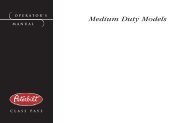MODEL 330 OPERATOR'S MANUAL - Peterbilt Motors Company
MODEL 330 OPERATOR'S MANUAL - Peterbilt Motors Company
MODEL 330 OPERATOR'S MANUAL - Peterbilt Motors Company
Create successful ePaper yourself
Turn your PDF publications into a flip-book with our unique Google optimized e-Paper software.
Operating the Transmission<br />
If you have a misaligned gear condition in your vehicle’s<br />
transmission and cannot start, gradually release the clutch,<br />
allowing the drive gear teeth to line up properly. Then the<br />
drive gear can roll enough to allow the teeth to line up properly<br />
and complete the shift.<br />
The best engine performance and maximum economy is<br />
obtained if gears are properly selected. This efficiency is<br />
achieved by always selecting gears within optimum engine<br />
rpm, which is where maximum torque and power are<br />
obtained. For further information, see “More Driving Tips<br />
and Techniques” on page 96.<br />
Shifting Gears in a New Vehicle<br />
Shift carefully in a new vehicle. The transmission may be a little<br />
stiff at first. Avoid gear clashing by closely following these<br />
procedures.<br />
When you are operating a new vehicle or one that has been<br />
exposed to cold weather, you want the transmission lubricant<br />
(fluid) to circulate and coat the contacting surfaces of the<br />
gears. Metal contacting metal in moving parts may seriously<br />
damage your transmission—do not drive in one gear for long<br />
periods of time until the transmission lubricant has a chance<br />
Operating Instructions<br />
to coat all contacting surfaces. Carefully observe the free<br />
travel in the clutch for the first few hundred miles. As the<br />
clutch lining wears and high spots get worn smooth, you will<br />
get less free travel.<br />
Clutch Brake and Travel (9–, 10–, and 11–Speed<br />
Transmissions only)<br />
These transmissions utilize a clutch brake, rather than synchronizers.<br />
The clutch brake works by stopping all of the<br />
gears in the transmission, allowing you to easily shift into first<br />
gear or reverse without grinding gears. The total stroke of the<br />
clutch pedal is about 10 inches. The first part is the release<br />
stroke: the part that fully releases the clutch. The last inch<br />
engages the clutch brake.<br />
During hard-shifting with vehicle not moving<br />
• To apply the clutch brake (while the vehicle is stopped)<br />
fully depress the clutch pedal to the floorboard to stop<br />
the gears. With the throttle at idle, select first gear then<br />
release the clutch pedal to let the vehicle start forward,<br />
until the clutch is fully engaged. See the manufacturer's<br />
Driver/Operator’s Instruction Manual for further details.<br />
– 66 – PB1318 3/01 Model <strong>330</strong>
















